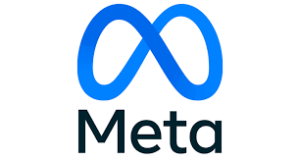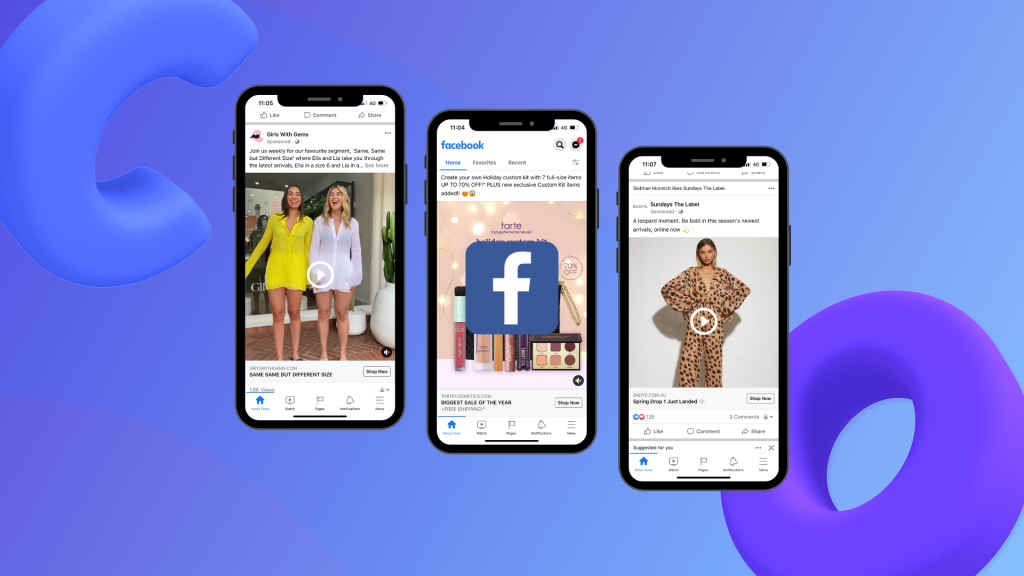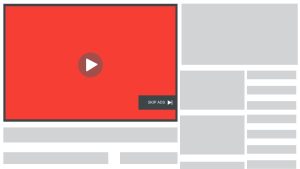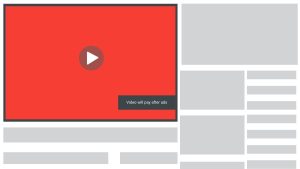Two Main Things You Need to Make Your eCommerce Site Convert
The global eCommerce market is growing, mainly due to the events of the past year, as well as the increased usage of smartphones and tablets. In fact, this 2021 it’s expected to total $4.81 trillion, wherein $3.56 trillion of which is projected to come from mobile eCommerce sales.
That said, it’s becoming increasingly important to make sure that your website is always optimised to generate conversions and sales. For those of you who have already started an eCommerce business, you’re probably already wondering what you can do to improve your current state and take advantage of the changes in the marketplace?
There are two main things you want to ensure that you’re making the most out of your eCommerce website:
Make Sure You’re Getting Relevant Traffic
One way to make sure that your budget is being spent to find potential customers searching for your products is to apply a keyword strategy and account structure that will ensure that you’re getting the right kind of traffic. Here, working with a Google Ads professional is important if you’re not sure how to go about setting it up on your Google Ads account.
Making sure that you’re attracting the right people is critical, especially if your goal is to increase conversions and sales on your website.
If your business is in the industry of health and wellness, for example, you want to avoid targeting general keywords. Be as specific as you can about your products and services, whether that’s cross fit training, bikram yoga sessions, organic produce, or essential oils, it’s important that your keywords are hitting the right note.
Apply the same specificity to your copy. Whether you’re running Google Display Ads or Facebook and Instagram Ads, your captions and copy should be engaging, targeted, and relevant with a clear call-to-action.
Optimise Your Website for Conversions
Once your Google Ads campaigns have achieved high relevancy, you need to audit and check on what users are doing once they reach your site. Find and identify any roadblocks that exist on your site and remove them. To accomplish that, go over to your Google Analytics dashboard and review your website and landing pages.
Google Analytics can track users’ engagement and movements on the site, giving you a good map of the path a converting customer travels. Through this, you can monitor and reflect on your traffic’s user experience, or what they do from the moment they visit your site to the moment that they click away.
You can also review each step of the checkout process, and dissect where your users are dropping off. All this data and information can help you make informed decisions on how to further improve your website experience.
Another useful tool for auditing is Crazy Egg, a little piece of software that analyses where your audience is coming from, what pages on your site they visit, and where they end up leaving or getting stuck at.
Crazy Egg also has the ability to draw you a heatmap of what particular parts of your website and landing pages that audiences actually engage with, such as which sections they linger on, or what buttons and links they click. This tool can provide you more than enough data on how you can better improve the audience’s overall experience on your website.
Now, all this can be a bit overwhelming, especially if you’re just starting out building out and growing your eCommerce website. That’s why it’s always a good idea to have professionals working with you to increase conversions and maximise your return on investment.
And if you’re looking to partner up with experts and professionals that are well-versed in the field, give one of our agents a call, and we can discuss how we can best help your business succeed in the online space.
5 Ways to Set Yourself Up for Google Shopping Success
Over the past year, consumer behaviour has transformed. In 2020, online shopping in Aussie households grew by 57%. In fact, out of 2.3 million low-frequency online shoppers, 52% were spending more time shopping online in 2020. These shoppers were said to have purchased items online at least 10 times between March and December of that year.
The big question is, are you making the most out of your digital marketing to reach these customers, or do you think you could do more? For businesses running Google Shopping ads, what are some ways that you can ensure that you’re making the most out of this opportunity?
We’ve listed below 5 easy steps to help you make sure that you’re doing the right things in optimising your Google Shopping ads. Let’s take a look.
1. Make sure your shopping feed is optimised
What is the Google Shopping feed? At its core, this is basically the spreadsheet that contains a list of all your product SKUs (stock-keeping units). It’s from this spreadsheet that Google sources the data and information it needs to determine whether your products are relevant to a user’s search query.
Just because it’s your product database, however, doesn’t mean that you should simply upload the spreadsheet directly onto the Google Merchant Centre. Doing this can cause problems such as duplicate listings, products not being listed at all, or even the suspension of your account.
To make sure that your database doesn’t run into any compatibility issues, go over it again and make sure that it contains information such as:
- Product ID
- Images
- Stock levels
- Title and descriptions
- Links to product landing pages
For a quick and easy reference, you can always check out Google’s Product Data Specification page to make sure that you have all the necessary information to ensure that your spreadsheet is optimised and ready.
2. Make sure your product descriptions contain relevant keywords
One thing that you have to note is that Google Shopping campaigns are a little bit different compared to Google search campaigns. With search campaigns, you’re bidding on keywords. Whereas with Google Shopping ads, you’re bidding on Product Groups.
But even though the bidding process is different, keywords still play an important role in making sure that your ads convert into clicks.
When writing out your product titles and descriptions, then, keep the customer in mind. Think about what keywords they would type trying to search for your products. It’s best to be specific, especially in the title, as you want to be able to grab your audience’s attention right away and have them say, “This is what I’m looking for.”
3. Continuously work on your Google Seller Ratings
What are Google Seller Ratings? Your Google Seller Ratings are actually your Google customer reviews. These reviews are the best way for you to fortify trust and authority with the audience you’re targeting, especially if they’re a cold audience. The higher your seller rating, the better your clicks and click-through rate will be.
To make your account eligible to display your Google Seller Rating, however, you first have to build up your customer reviews. Google requires that you be able to collect around 100 or more reviews within the last 12 months for them to be able to calculate and showcase your seller rating score.
That means it’s important to be consistent in asking customers for reviews. Create a system within your business wherein you always ask a customer if they could leave a review and you should be well on your way to collecting 100.
4. Pay attention to your bidding
When it comes to Google Shopping success, bidding is definitely something that you have to keep an eye out for. If you’re also currently running Google Ads, it’s important to note that there’s a difference in the bidding process for Google Shopping. For Google shopping, you’re bidding for visibility and not just placement.
Unlike search ads, your bidding strategy with Google Shopping ads will determine whether your ad will show up or not. Here, testing is important. Keep testing to see which bids are working for you. Don’t overbid, as doing so can have your ads appear for more generalised queries, hurting your results in the long run. Bidding high, in this case, isn’t always the best solution.
5. Optimise your campaign structure
Last, but not least, make sure that your campaign structure is optimised and segmented properly. This can make or break your campaign.
Shopping behaviours are different, whether the user is shopping on their mobile devices, or on their laptops and desktops. In 2020, 91% of online shoppers use their mobile phones to make purchases, while 76% did so through a laptop computer, and 61% on their tablets.
Segmenting your campaigns based on the device is one way to structure your campaign, as shoppers on a mobile phone will behave differently than one doing so on a computer. And although a computer is the preferred purchasing device during the holidays, the mobile phone is the winner overall.
Another way you would want to structure your campaign is to segregate your products into different ad groups. Group them according to price. Give your high-priced items more exposure, as they can give you the highest margins, and lower your bidding for your low-priority products. Aim to achieve a sense of balance with your bidding so that you can get the most out of your ad spend.
Of course, all of this can be time-consuming, especially during the holiday season. But that’s why paid ads agencies like Get More Traffic exist. If you’re looking to start or optimise a Google Shopping campaign, feel free to get on a call with one of our agents so that we can discuss how we can best serve you and set you up for success.
Digital Marketing Industry Updates – June
Latest Updates from Instagram: New Reels & Live Video Analytics, and Likes! (GMT)
Back in 2019, Instagram decided to remove the like counts in Australia to pave the way for a safer internet space. This, of course, posed certain obstacles and limitations for brands and influencers in keeping track of trends and engagement rates. Recently, however, Instagram released a new feature that now allows users to choose whether they want to have the like counts visible or invisible. The new opt-in feature for hiding likes can be found in your privacy settings. However, even though hidden, you can still view like counts through the analytics account.
Instagram also announced the release of new native data for their reel and live video features to help marketers track and analyse their performance. Additional metrics for Reels include plays, accounts reached, likes, comments, saves, and shares. Whereas for live video, the new metrics being rolled out include accounts reached, peak concurrent viewers, comments, and shares. Instagram ensures creators and businesses that these new measurements can better help them understand how well their content is performing. However, these new analytics are only available to Business and Creator accounts. To find them, simply tap on the “Insights” button from your profile page and you can view up your latest metrics for up to 30 days.
New Google Ad Formats for Local Campaigns (GMT)
Several new Google Ads formats were launched late last month centering around local campaigns. These new formats include: Auto-Suggest Ads, Navigational Ads, Similar Place Ads, and Pickup Later ads. All the newly launched ad formats are based on location. First up, Auto-Suggest Ads are shown when a searcher is located close by to a related product or service on Google Maps. Navigational Ads, on the other hand, are shown while a user is using Google Maps driving directions and can be displayed as a user is driving towards a destination. Thirdly, Similar Place Ads appear when the business searched is closed, and so the user is instead shown a similar business on the map, potentially capturing traffic that would otherwise be directed towards competitors. With all these new features in place, local business and advertisers will have more opportunities to reach customers in the surrounding areas using localized results to offer the best user experience.
Goodbye Broad Match Keywords (GMT)
One major updated that happened with Google Search campaigns this 2021 is the phasing out of the Broach Match modifier keyword match type. This change saw Phrase Match expand to include the additional Broach Match traffic in a bid to increase effectiveness quoting that “…You reach more of the right customers through a combination of the two”. If you are currently running Search campaigns on Google, make sure to reach out to your Account Manager to check how this might affect your current campaigns.
Automated AI-Driven Optimisations (GMT)
This 2021, In a move to further expand automation and AI-driven improvements, Google Ad’s recommended optimisations feature moved from ‘suggested’ to auto-applied instead. Reviews of the change have been mixed as the AI-driven optimisations don’t always consider the nuances in optimisation that are part of certain industries. Thus, the 35 editable options are still opt-out. If you’re interested in finding out more about how AI-driven optimisations can potentially impact your campaign, make sure to schedule some time for a chat with your Account Manager.
AdWords Management Pointers For Entrepreneurs
Google AdWords is a tricky platform to navigate at the best of times, let alone when you’re a busy entrepreneur focusing on trying to grow a business. You to set your ad groups, keywords, write ad copy and so much more. At Get More Traffic, we specialise in the production of affordable yet effective AdWords campaigns for small to medium entrepreneurs. With this expertise, we’ve compiled a list of three simple AdWords management pointers that can assist you in helping your campaigns run more smoothly.
AdWords Techniques To Turn A Profit
Having trouble wrapping your head around the best ways to take advantage of Google Adwords to execute an effective PPC campaign? With a variety of options to customise each ad campaign, it’s easy to get lost in Google AdWords for hours. Keeping in mind that each business will have varying target audiences, we’ve listed some general AdWords techniques to turn a profit for your business.
Three AdWords Mistakes You’re Making (And How To Fix ‘Em)
Adwords management is a constantly changing entity; just when you think you’ve mastered it, some new technique pops up. While it’s good to stay on your toes, constant updates with SEO practices can leave room for complacency, mistakes and misconceptions regarding the best Adwords practices. Below, we list three common AdWords mistakes companies often make, and how to avoid them.
Discover The New Google AdWords Features For 2017!
In their bid to continue making AdWords as relevant as possible to today’s users, Google have just announced a new 2017 AdWords update! Keen to find out what’s new? Just keep reading!
Overview Page
When it comes to your Overview page, you want your insights to be fast and user friendly yes? Well according to Google, this is what the most recent changes will achieve; removing clutter and making navigation easier.
From those who’ve already sampled the new features, the response seems to be mostly positive. Praise for the new layout includes its faster and more intuitive functions, which, according to one advertiser, make it ‘easier to get things done’.
As can be seen via the below images from AdWords, the new layout will allow users to more easily view key insights through heat-map style charts; displaying data on which locations and days of the week are achieving the best results.
According to Browsermedia, these maps may also be interactive – which would allow users to alter the metrics to suit their preference.
“Above you can see clicks and impressions in the ‘Day & Hour’ and ‘Locations’ charts, respectively, but there is a drop down next to the metric so hopefully that can be changed to conversions etc, to see data for those too,” they write.
According to AdWords these changes will be rolled out over the coming months, and may be seen by some users automatically upon signing into AdWords.
3 AdWords Christmas Tips To Prevent Extra Stress
Whether you’re going away or staying close to home, one thing is certain – you want the holiday period to go as smoothly as possible! For some, Christmas is regarded as one of the most stressful times of year. So for this reason, we’re sharing our ‘Top Three AdWords Christmas Tips’ to make life easier!
#1: Download the AdWords App
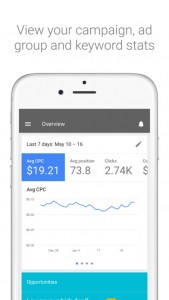
If there’s one thing you do before the end of the year, make sure you download this app! Not only will it allow you to more easily monitor your budgets and daily bids on-the-go, but you’ll also receive real-time alerts if your budget runs out or your ads are disapproved. According to Google’s AdWords blog, the app will also allow you to:
- Ensure you don’t miss out on key shopping dates.
- Make time-sensitive changes to your campaigns, or pause them if necessary.
- Easily adjust budgets and bids for campaigns that are performing above average.
- Review daily performance metrics, allowing you to “understand how your campaigns are performing and if you need to make any last-minute adjustments.”
#2: Take Note of Your Campaign Timing
I’m sure you’ve heard the saying, ‘time is money,’ and this is especially true in terms of your Christmas AdWords campaigns. During the holiday period it’s crucial to make sure your ads are scheduled during the most optimal times. For example, if you’re running a Christmas campaign, make sure it begins in the week before Christmas so you can convert more of the excess traffic coming through.
#3: Ensure Your Campaigns are Tightly Grouped
While it’s definitely an important consideration all year round, making sure your campaigns are tightly organised becomes even more so during the holiday period. According to WordStream, strong account and campaign organisation “makes it easier to coordinate, adjust, and run time-sensitive campaigns,” while also ensuring an increase in your Quality Scores.
To ensure your campaigns are organised at the optimal level, try containing seasonal products within unique ad groups, and tightly theming your keywords.
Whatever your plans are for the holiday period, you can breathe a little easier with these three AdWords Christmas tips. The key is to ensure you’re well organised before Christmas hits, and then sit back and watch the conversions roll in!
Looking for an expert to help you plan your AdWord campaigns this Christmas? Reduce your holiday stress by allowing one of our Get More Traffic experts to take a look at your account. Call us today on 1300 332 256!




